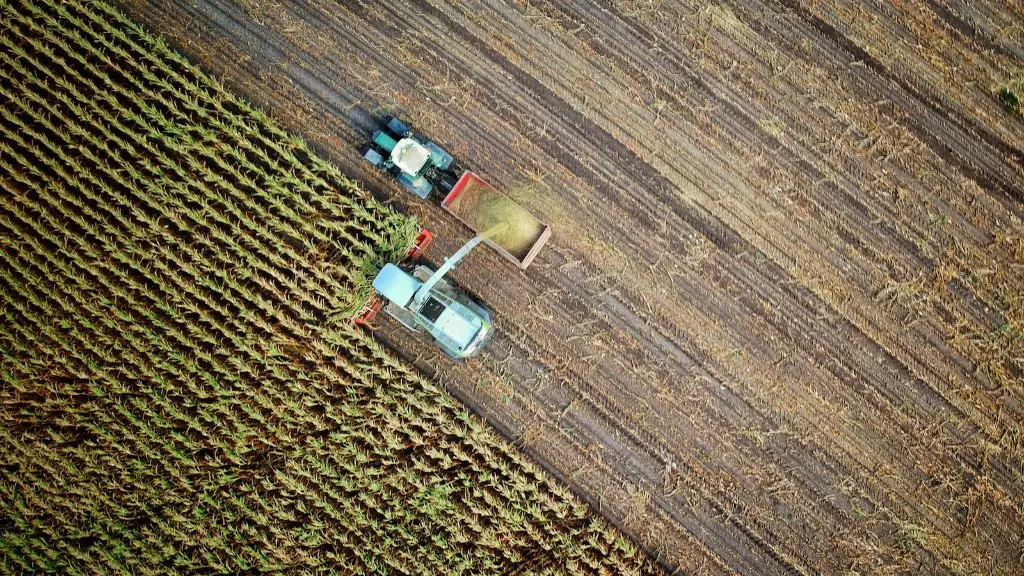The North American Free Trade Agreement (NAFTA) has had a considerable effect on the agricultural sector. Ever since it was implemented in 1994, NAFTA has provided expanded market access to farmers and increased agricultural production in the United States, Canada, and Mexico, and continues to be a vital part of the agricultural industry. NAFTA has allowed farmers to export their products at a faster rate and helped to reduce production costs and the prices of agricultural goods.
NAFTA provides greater market access for agricultural exports in all three countries, leading to higher demand and lower prices for farm products. This has allowed farmers to increase their production, as well as exporting more goods to other markets. With additional market access, farmers have been able to take advantage of more lucrative opportunities, leading to greater expansion of the agricultural sector.
NAFTA has also enabled increased agricultural research and development. Lower market access barriers in all three countries have allowed for increased funding for agricultural research projects, leading to more innovative farming techniques, improved technology and better crop yields. This has helped farmers remain competitive in the global market.
In addition, NAFTA has facilitated the movement of agricultural products across the three countries. The treaty has enabled farmers in all three countries to transport their products to domestic and international markets with little difficulty, allowing them to compete against other international producers. NAFTA has made it easier for farmers to trade their products, leading to increased profits.
Lastly, NAFTA has allowed farmers to benefit from lower production costs due to its open trading environment. This has led to improved access to input supplies and greater availability of farm inputs, resulting in more competitive farm prices and improved productivity. As a result, farmers are able to produce more, leading to higher demand for their products.
Impact on Labor
NAFTA has had a major impact on the agricultural labor force. Since it was implemented, the number of agricultural laborers has increased significantly due to the increased market access and reduced production costs. This has helped many agricultural workers find employment and earn higher wages, which in turn has contributed to the overall economic growth of the three countries.
At the same time, the agreement has led to the displacement of some agricultural laborers due to the increased competition and reduced farm prices. Although the decrease in farm prices has benefited consumers, it has also put a strain on traditional farm laborers, as some have been forced to reduce their hours, find alternate employment, or even relocate.
In addition, NAFTA has also contributed to greater wage inequality among farm workers, as farmers in the US and Canada have been able to pay higher wages than those in Mexico. This has led to a “brain drain” of workers from Mexico to the US, as workers seek better wages and better working conditions. This has had a detrimental effect on the Mexican agricultural industry, as many of its workers have been unable to find employment at home.
Finally, NAFTA has enabled increased mechanization of the agricultural sector, as farmers have had access to increased capital and technology. This has led to reduced labor costs, as machines can do a lot of the farm work that would normally need to be done manually. At the same time, it has put a strain on traditional farm laborers, as the number of available jobs has declined.
Impact on the Environment
NAFTA has had a mixed impact on the environment. On one hand, the increased trade has enabled farmers to access better technology and inputs, resulting in increased agricultural efficiency. This has led to fewer inputs being used per acre, less fuel and water being used, and fewer pollutants being released into the environment. However, this has also led to a depletion of natural resources and the emergence of new environmental risks.
For example, increased trade in commodities, such as corn and soybeans, has led to a greater demand for these crops, resulting in an increased use of fertilizers and pesticides. This has led to a loss of soil fertility and an increase in the amount of pollutants being released into the environment. Additionally, NAFTA has led to the importation of livestock and other animals, resulting in an increased risk of new animal diseases and a loss of biodiversity.
Similarly, NAFTA has enabled the movement of agricultural inputs, such as fertilizers and pesticides, across international borders, leading to increased contamination of agricultural areas. Pollutants have been released into waterways and soil, leading to the emergence of new environmental hazards. Lastly, NAFTA has led to an increased strain on the water supply, as increased irrigation is needed for higher crop yields.
Impact on Trade
NAFTA has had a significant impact on the trade of agricultural products. The agreement has enabled agricultural producers in all three countries to take advantage of new market opportunities and gain access to a larger global market. This has enabled agricultural producers to increase their exports, leading to higher profits.
However, NAFTA has had a negative impact on the trade of certain agricultural products. A lack of tariff and non-tariff barriers in the agreement have enabled imports of agricultural products to be sold at prices that are lower than domestically produced goods. This has put a strain on some agricultural producers, as they are unable to compete against cheaper imports, leading to lower profits and fewer jobs.
Additionally, NAFTA has enabled agricultural producers to increase the scale of their operations, as they have access to new markets and finance. This has led to the emergence of larger farms, but has also contributed to the displacement of smaller-scale farmers. In some cases, producers have adopted new and more efficient farming technologies, which have ultimately led to higher costs and displacement of traditional agricultural workers.
Furthermore, the agreement has resulted in increased subsidies for agricultural producers, as governments in all three countries have provided support to their farmers. These subsidies have enabled farmers to remain competitive in the marketplace, but have also led to an increase in the amount of food production, leading to an oversaturation of the market.
Impact on Consumption
Finally, NAFTA has had a significant impact on consumption patterns in all three countries. The agreement has made more agricultural products available at a lower cost, leading to reduced prices and a greater range of products. This has enabled consumers to purchase agricultural goods at a cheaper rate than if they had purchased them domestically, resulting in a better quality of life and a wider range of options.
At the same time, NAFTA has enabled the importation of agricultural products from other countries, such as China, Brazil, and Argentina. This has increased competition and led to fluctuations in the prices of agricultural goods. Additionally, NAFTA has enabled the movement of agricultural products across countries, resulting in higher transportation costs and an increase in food waste.
In addition, the agreement has enabled agricultural producers to increase their production and sell their goods in international markets. This has led to an oversupply of agricultural commodities, resulting in lower prices and higher food waste. Finally, it has enabled agricultural producers to produce and sell their products at a lower cost, leading to reduced wages for agricultural laborers.
Social Impacts
NAFTA has had a significant impact on the social fabric of all three countries. Increased trade and investment have led to improved infrastructure and better access to markets and financing. As a result, some farmers have been able to increase their production and their profits, leading to an improvement in their socio-economic status.
At the same time, NAFTA has enabled increased imports of agricultural products, leading to a decrease in the price of domestic goods and a decrease in the wages for agricultural laborers. This has exacerbated the rural-urban divide in all three countries, as struggling farmers are seen as competing with cheaper imports for scarce resources.
Furthermore, increased trade has resulted in a rapid increase in the consumption of agricultural products. This has resulted in a greater demand for agricultural goods and has led to higher prices for farm products. In some cases, this has led to an increase in food prices and a decrease in food availability.
Finally, NAFTA has enabled increased mechanization of agriculture and the displacement of traditional agricultural workers. This has led to a decrease in job opportunities, lower wages, and an overall decline in the quality of life for many rural workers.





